warning light MITSUBISHI iMiEV 2015 Owner's Manual (in English)
[x] Cancel search | Manufacturer: MITSUBISHI, Model Year: 2015, Model line: iMiEV, Model: MITSUBISHI iMiEV 2015Pages: 262, PDF Size: 26.84 MB
Page 10 of 262

2-1
2
If this warning light comes on or
flashes while you’re driving...
Quick index
N00200702188
If this warning light comes on
or flashes while you’re driving...
NOTE
These warning lights will come on for a few se
conds for a bulb check when the electric
motor switch is first turned to “ON”.
Warning light
Do this
Ref. page
12V starter battery charging system warning
light
Park your vehicle in a safe place a
nd turn off the electric motor unit.
Contact a certified i-MiEV dealer for assistance.
P.5-43
or
Brake warning light
If this light comes on while driving, ch
eck to see that the parking brake is
fully released. If this light stays on after releasing
the parking brake, stop and check the
brake fluid level. If the brake fluid level is correct, ther
e may be a system
malfunction. Avoid
hard braking and high speeds, and cont
act a certified i-MiEV dealer for
assistance.
P.5-42
Electric motor unit warning light
Park your vehicle in a safe place and
contact a certified
i-MiEV dealer for
assistance.
P.5-43
BK0209800US.book 1 ページ 2014年1月14日 火曜日 午前9時26分
Page 11 of 262

If this warning light comes on or flashes while you’re driving... 2-2 Quick index
2
Electric power steering
system (EPS) warning
light
If this light comes on while the elec
tric motor unit is running, it may
become harder to turn the steering wh
eel. Have your vehicle inspected at a
certified i-MiEV
dealer as soon as possible.
P. 5 - 2 8
Anti-lock braking system warning light
When this light comes on, the anti-l
ock braking system is not functioning
and only the ordinary brak
ing system is functioning.
Park your vehicle in a safe plac
e and stop the electric motor unit.
Test the system as described on page 5-27. If the light does not go out
after the test, or if it comes on again, we recom-
mend that you have the system checked
at a certified i-MiEV dealer as
soon as possible.
P.5-26, 5-27
SRS warning light
Immediately have the airb
ag and the seat belt pre-
tensioner system checked
at a certified i-MiEV dealer.
P.4-13, 4-26
Power down warning light
If this light comes on while driving,
avoid sudden acce
leration and sudden
starting. When the remaining power in the main drive lithium-ion battery is low, recharge the main drive lithium-ion battery as soon as possible.
P. 5 - 4 3
Warning light
Do this
Ref. page
BK0209800US.book 2 ページ 2014年1月14日 火曜日 午前9時26分
Page 12 of 262
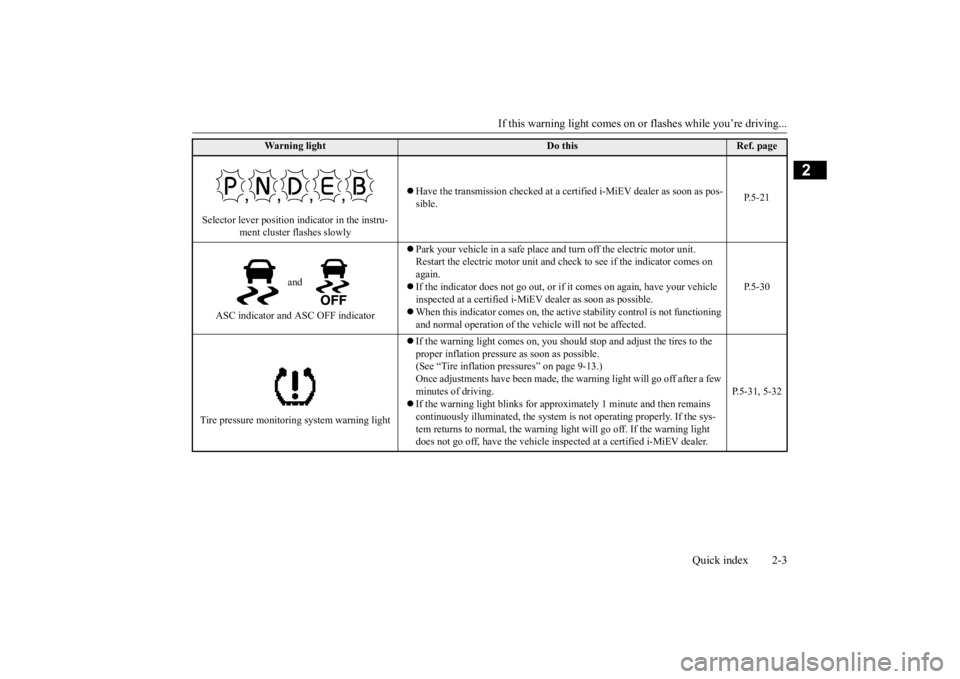
If this warning light comes on or
flashes while you’re driving...
Quick index 2-3
2
Selector lever position indicator in the instru-
ment cluster flashes slowly
Have the transmission checked at a cert
ified i-MiEV dealer as soon as pos-
sible.
P.5-21
and
ASC indicator and ASC OFF indicator
Park your vehicle in a safe place a
nd turn off the electric motor unit.
Restart the electric motor unit and check to see if the indicator comes on again. If the indicator does not go out, or if it
comes on again, have your vehicle
inspected at a certified i-MiEV
dealer as soon as possible.
When this indicator comes on, the acti
ve stability contro
l is not functioning
and normal operation of the vehi
cle will not be affected.
P.5-30
Tire pressure monitoring system warning light
If the warning light comes on, you shoul
d stop and adjust the tires to the
proper inflation pressure
as soon as possible.
(See “Tire inflation pr
essures” on page 9-13.)
Once adjustments have been made, the
warning light will go off after a few
minutes of driving. If the warning light blinks for appr
oximately 1 minute and then remains
continuously illuminated, the system is
not operating properly. If the sys-
tem returns to normal, the warning li
ght will go off. If the warning light
does not go off, have the vehicle insp
ected at a certified i-MiEV dealer.
P.5-31, 5-32
Warning light
Do this
Ref. page
BK0209800US.book 3 ページ 2014年1月14日 火曜日 午前9時26分
Page 17 of 262
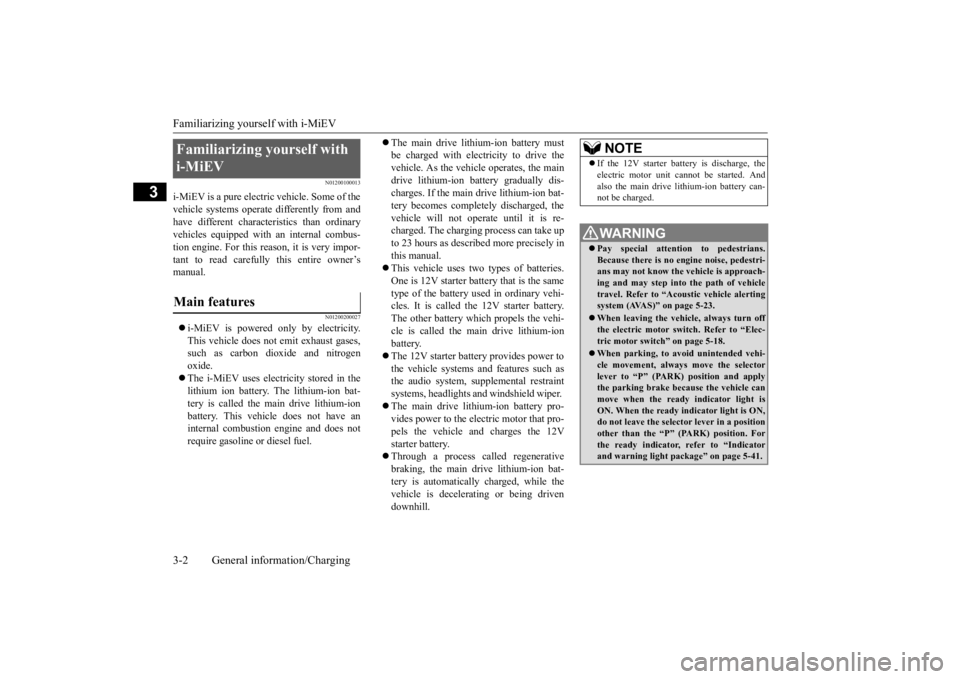
Familiarizing yourself with i-MiEV 3-2 General information/Charging
3
N01200100013
i-MiEV is a pure electric vehicle. Some of the vehicle systems operate differently from and have different characteristics than ordinaryvehicles equipped with an internal combus- tion engine. For this reas
on, it is very impor-
tant to read carefull
y this entire owner’s
manual.
N01200200027
i-MiEV is powered only by electricity. This vehicle does not
emit exhaust gases,
such as carbon dioxide and nitrogenoxide. The i-MiEV uses electricity stored in the lithium ion battery. The lithium-ion bat-tery is called the main drive lithium-ion battery. This vehicl
e does not have an
internal combustion engine and does notrequire gasoline
or diesel fuel.
The main drive lithium-ion battery must be charged with electricity to drive thevehicle. As the vehi
cle operates, the main
drive lithium-ion battery gradually dis- charges. If the main drive lithium-ion bat-tery becomes completely discharged, the vehicle will not
operate until it is re-
charged. The charging process can take upto 23 hours as descri
bed more precisely in
this manual. This vehicle uses two types of batteries. One is 12V starter battery that is the same type of the battery used in ordinary vehi-cles. It is called the 12V starter battery. The other battery which propels the vehi- cle is called the main drive lithium-ionbattery. The 12V starter battery provides power to the vehicle systems and features such asthe audio system, supplemental restraint systems, headlights a
nd windshield wiper.
The main drive lithium-ion battery pro- vides power to the electric motor that pro- pels the vehicle and charges the 12V starter battery. Through a process called regenerative braking, the main drive lithium-ion bat- tery is automatically charged, while thevehicle is decelera
ting or being driven
downhill.
Familiarizing yourself with i-MiEV Main features
NOTE
If the 12V starter batter
y is discharge, the
electric motor unit ca
nnot be started. And
also the main drive lithium-ion battery can-not be charged.WA R N I N G Pay special attention to pedestrians. Because there is no engine noise, pedestri- ans may not know the vehicle is approach-ing and may step into
the path of vehicle
travel. Refer to “Aco
ustic vehicle alerting
system (AVAS)” on page 5-23. When leaving the vehicl
e, always turn off
the electric motor switch. Refer to “Elec-tric motor switch” on page 5-18. When parking, to avoi
d unintended vehi-
cle movement, always move the selector lever to “P” (PARK)
position and apply
the parking brake because the vehicle canmove when the ready indicator light is ON. When the ready indicator light is ON, do not leave the select
or lever in a position
other than the “P” (PARK) position. For the ready indicator,
refer to “Indicator
and warning light pack
age” on page 5-41.
BK0209800US.book 2 ページ 2014年1月14日 火曜日 午前9時26分
Page 23 of 262
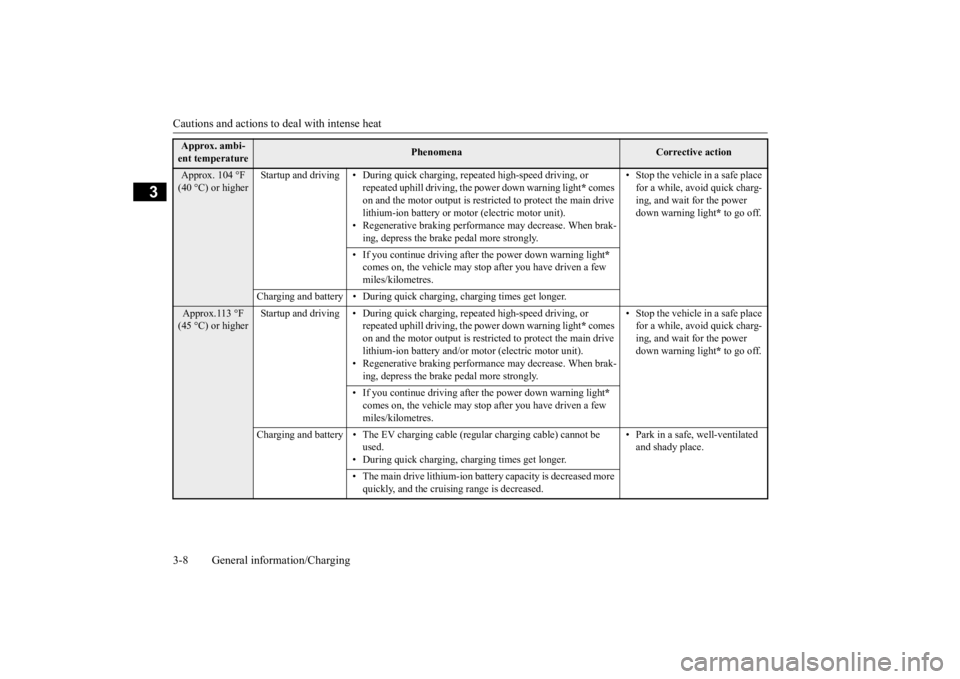
Cautions and actions to deal with intense heat 3-8 General information/Charging
3
Approx. ambi- ent temperature
Phenomena
Corrective action
Approx. 104 °F (40 °C) or higher
Startup and driving •
• During quick charging, repeated high-speed driving, or repeated uphill driving,
the power down warning light
* comes
on and the motor output is restrict
ed to protect the main drive
lithium-ion battery or mo
tor (electric motor unit).
Regenerative braking performance
may decrease. When brak-
ing, depress the brake pedal more strongly.
• Stop the vehicle in a safe place for a while, avoid quick charg- ing, and wait for the power down warning light
* to go off.
• If you continue driving after the power down warning light
*
comes on, the vehicle may stop
after you have driven a few
miles/kilometres.
Charging and battery • During quick
charging, charging times get longer.
Approx.113 °F (45 °C) or higher
Startup and driving •
• During quick charging, repeated high-speed driving, or repeated uphill driving,
the power down warning light
* comes
on and the motor output is restrict
ed to protect the main drive
lithium-ion battery and/or motor (electric motor unit). Regenerative braking performance
may decrease. When brak-
ing, depress the brake pedal more strongly.
• Stop the vehicle in a safe place for a while, avoid quick charg-ing, and wait for the power down warning light
* to go off.
• If you continue driving after the power down warning light
*
comes on, the vehicle may stop
after you have driven a few
miles/kilometres.
Charging and battery •
• The EV charging cable (regular charging cable) cannot be used. During quick charging, ch
arging times get longer.
• Park in a safe, well-ventilated and shady place.
• The main drive lithium-ion batt
ery capacity is decreased more
quickly, and the cruisi
ng range is decreased.
BK0209800US.book 8 ページ 2014年1月14日 火曜日 午前9時26分
Page 24 of 262
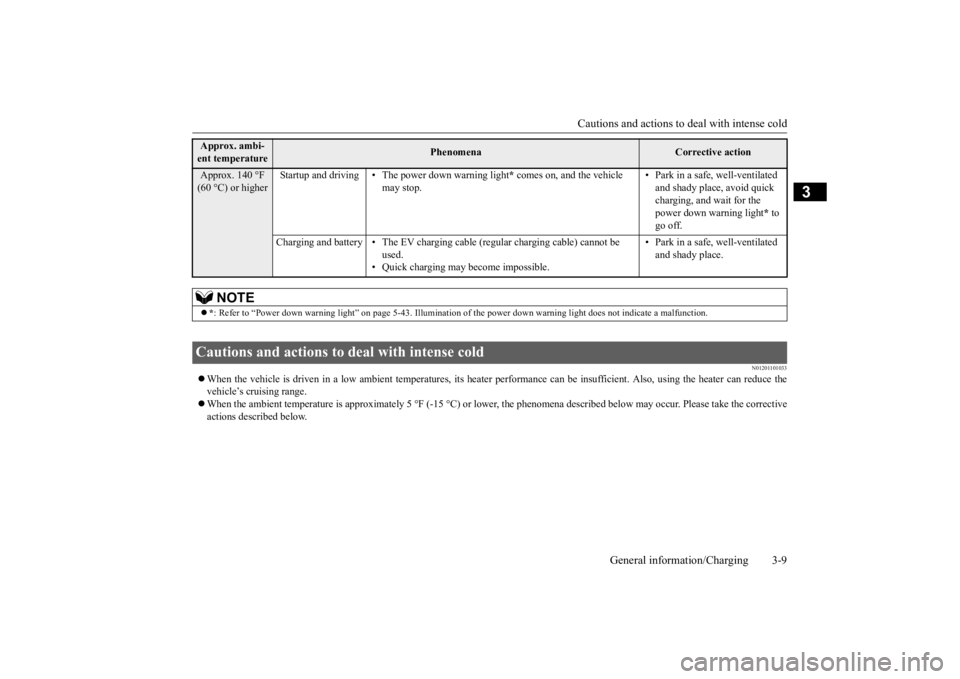
Cautions and actions to deal with intense cold
General information/Charging 3-9
3
N01201101033
When the vehicle is driven in a low ambient temperatures, its he
ater performance can be insuffic
ient. Also, using the heater ca
n reduce the
vehicle’s cruising range. When the ambient temperature is approximate
ly 5 °F (-15 °C) or lower, the phenomena de
scribed below may occu
r. Please take the
corrective
actions described below.Approx. 140 °F (60 °C) or higher
Startup and driving • The power down warning light
* comes on, and the vehicle
may stop.
• Park in a safe, well-ventilated and shady place,
avoid quick
charging, and wait for the power down warning light
* to
go off.
Charging and battery •
• The EV charging cable (regular
charging cable) cannot be
used.Quick charging may become impossible.
• Park in a safe, well-ventilated and shady place.
NOTE
*: Refer to “Power down warning light” on pa
ge 5-43. Illumination of the power down wa
rning light does not i
ndicate a malfunctio
n.
Cautions and actions to deal with intense cold Approx. ambi- ent temperature
Phenomena
Corrective action
BK0209800US.book 9 ページ 2014年1月14日 火曜日 午前9時26分
Page 25 of 262
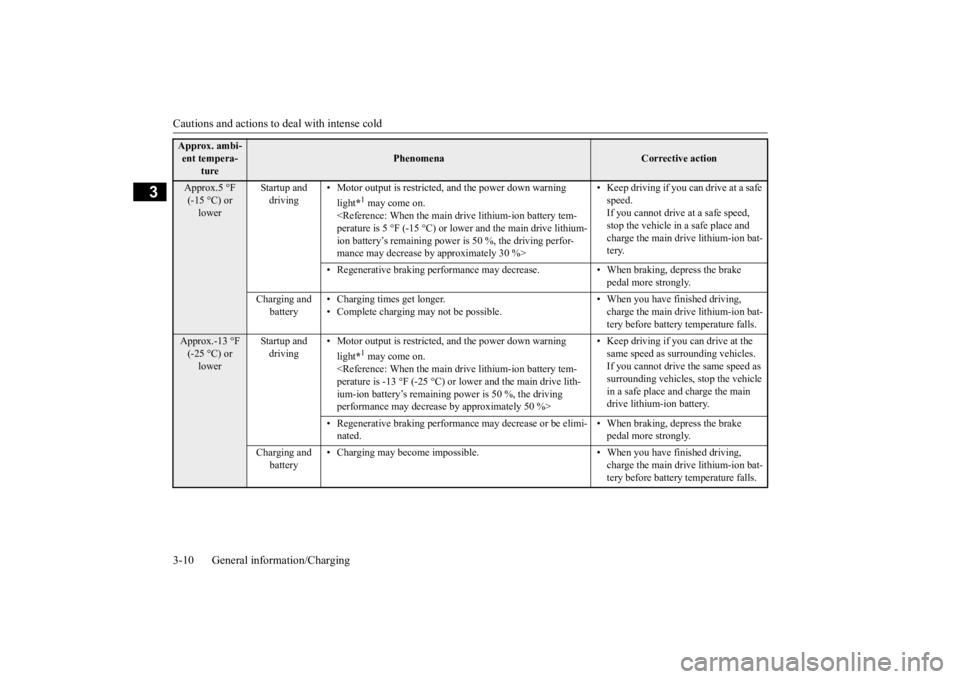
Cautions and actions to deal with intense cold 3-10 General information/Charging
3
Approx. ambi- ent tempera-
ture
Phenomena
Corrective action
Approx.5 °F (-15 °C) or lower
Startup and driving
• Motor output is restricted
, and the power down warning
light
*1 may come on.
• Keep driving if you can drive at a safe speed. If you cannot drive at
a safe speed,
stop the vehicle in a safe place and charge the main drive lithium-ion bat- tery.
• Regenerative braking performance may decr
ease. • When braking, depress the brake
pedal more strongly.
Charging and
battery
• • Charging times get longer. Complete charging may not be possible.
• When you have finished driving, charge the main drive lithium-ion bat- tery before battery temperature falls.
Approx.-13 °F (-25 °C) or lower
Startup and driving
• Motor output is restricted
, and the power down warning
light
*1 may come on.
• Keep driving if you can drive at the same speed as su
rrounding vehicles.
If you cannot drive th
e same speed as
surrounding vehicles, stop the vehicle in a safe place and charge the main drive lithium-ion battery.
• Regenerative braking performance
may decrease or be elimi-
nated.
• When braking, depress the brake pedal more strongly.
Charging and
battery
• Charging may become impossible. • W
hen you have finished driving, charge the main drive lithium-ion bat- tery before battery temperature falls.
BK0209800US.book 10 ページ 2014年1月14日 火曜日 午前9時26分
Page 26 of 262
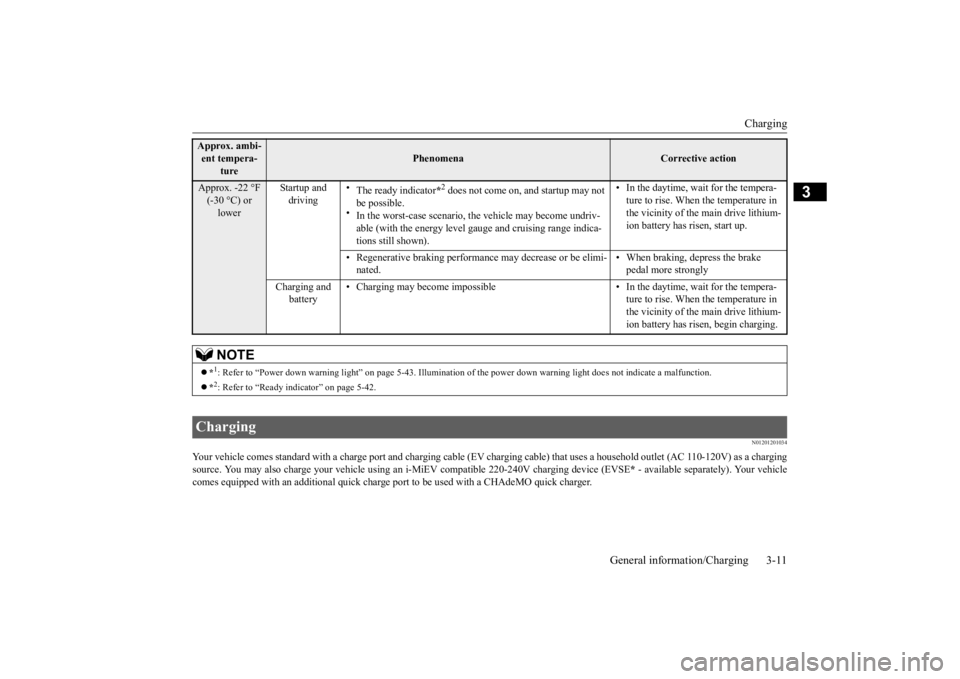
Charging
General information/Charging 3-11
3
N01201201034
Your vehicle comes standard with a charge
port and charging cable (EV charging cable)
that uses a household outlet (AC 110-120V
) as a charging
source. You may also charge your
vehicle using an i-MiEV compatib
le 220-240V charging device (EVSE
* - available separate
ly). Your vehicle
comes equipped with an additiona
l quick charge port to be used
with a CHAdeMO quick charger.
Approx. -22 °F (-30 °C) or lower
Startup and driving
• • The ready indicator
*2 does not come on, and startup may not
be possible. In the worst-case scenario,
the vehicle may become undriv-
able (with the energy level ga
uge and cruising
range indica-
tions still shown).
• In the daytime, wait for the tempera- ture to rise. When the temperature in the vicinity of the main drive lithium-ion battery has risen, start up.
• Regenerative braking performan
ce may decrease or be elimi-
nated.
• When braking, depress the brake pedal more strongly
Charging and
battery
• Charging may become impossible • In
the daytime, wait for the tempera- ture to rise. When the temperature in the vicinity of the main drive lithium- ion battery has risen, begin charging.
NOTE
*1: Refer to “Power down warning light” on
page 5-43. Illumination of
the power down warning light
does not indicate a malfunctio
n.
*2: Refer to “Ready indicator” on page 5-42.
Charging Approx. ambi- ent tempera-
ture
Phenomena
Corrective action
BK0209800US.book 11 ページ 2014年1月14日 火曜日 午前9時26分
Page 43 of 262
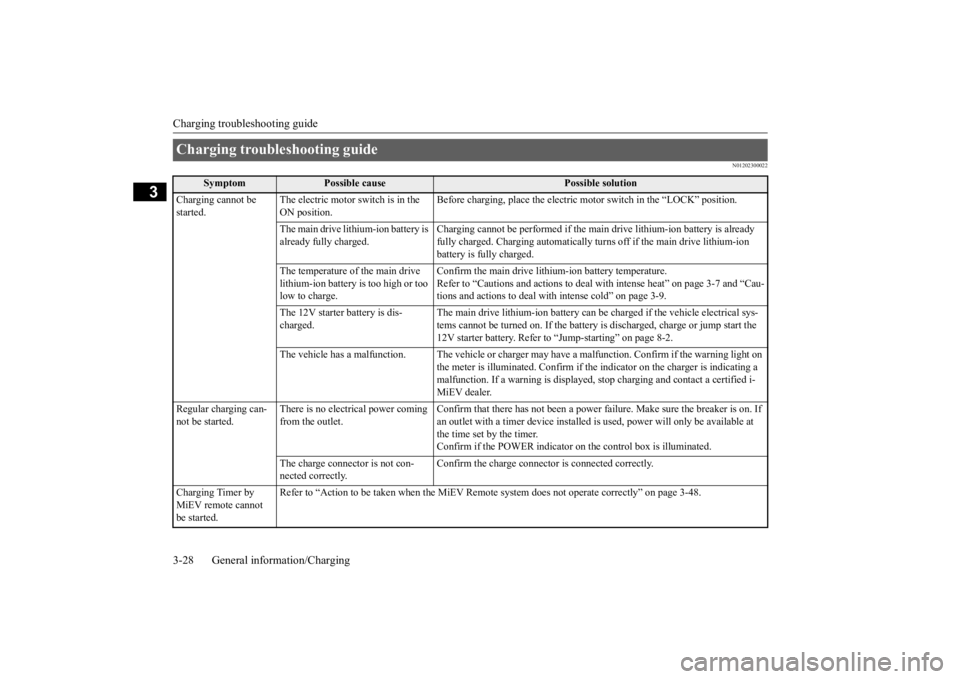
Charging troubleshooting guide 3-28 General information/Charging
3
N01202300022
Charging troubleshooting guide
Symptom
Possible cause
Possible solution
Charging cannot be started.
The electric motor switch is in the ON position.
Before charging, place the electric motor switch in the “LOCK” position.
The main drive lithium-ion battery is already fully charged.
Charging cannot be performed if the ma
in drive lithium-ion
battery is already
fully charged. Charging automatically turns off if the main drive lithium-ion battery is fully charged.
The temperature of the main drive lithium-ion battery
is too high or too
low to charge.
Confirm the main drive lithium-ion battery temperature. Refer to “Cautions and acti
ons to deal with intense heat” on page 3-7 and “Cau-
tions and actions to deal wi
th intense cold” on page 3-9.
The 12V starter battery is dis- charged.
The main drive lithium-ion battery can be charged if the vehicle electrical sys- tems cannot be turned on. If the battery is
discharged, charge or jump start the
12V starter battery. Refer to
“Jump-starting” on page 8-2.
The vehicle has a malf
unction. The vehicle or charger
may have a malfunction. Confir
m if the warning light on
the meter is illuminated. Confirm if the indicator on the charger is indicating a malfunction. If a warning is displayed,
stop charging and contact a certified i-
MiEV dealer.
Regular charging can- not be started.
There is no electrical power coming from the outlet.
Confirm that there has not been a power fa
ilure. Make sure the breaker is on. If
an outlet with a timer device installed
is used, power will onl
y be available at
the time set by the timer. Confirm if the POWER indicator on
the control box
is illuminated.
The charge connector is not con- nected correctly.
Confirm the charge connector
is connected correctly.
Charging Timer by MiEV remote cannot be started.
Refer to “Action to be taken when the MiEV Remote
system does not operate correctly” on page 3-48.
BK0209800US.book 28 ページ 2014年1月14日 火曜日 午前9時26分
Page 46 of 262

High-Voltage components
General information/Charging 3-31
3
Leaks or damage to the main drive lith- ium-ion battery may result in a fire. If youdiscover them, contact emergency servicesimmediately. Since the fluid leak may be lithium manganite from the Lithium-ion battery, never touch any fluid leakingfrom the inside or outs
ide of the vehicle. If
the fluid contacts you
r skin or eyes, wash
it off immediately with a large amount ofwater and receive immediate medical attention to help
avoid serious injury.
If you are unable to sa
fely assess the vehi-
cle due to vehicle damage, do not touch the vehicle. Leave the vehicle and contactemergency services. Advise emergency responders that this is
an electric vehicle.
If a fire occurs in th
is vehicle,
leave the
vehicle as soon as possible and contact emergency services. Do not attempt toextinguish a fire by yourself. If the fire involves a lithium-ion battery, it will require large, sustained volumes of waterfor extinguishment. Using a small amount of water or the incorrect fire extinguisher can result in serious injury or death fromelectrical shock. When you leave the ve
hicle, if possible,
open the windows,
doors and liftgate to
prevent accumulation of poisonous/com- bustible gasses. This will also assist in therescue and fire fighting process.WA R N I N G
As with any vehicle fi
re, the byproducts of
combustion can be toxic. Do not inhalesmoke, vapors, or gas
from the vehicle.
Move to a safe distance upwind and uphill from the vehicle fire
and out of the way of
any oncoming traffic
while awaiting the
arrival of emergency responders. If you detect leaking
fluids, sparks, smoke,
flames, gurgling, popping or hissing noises originating from the
high voltage battery
compartment, contact emergency servicesimmediately. This may result in a fire. Physical damage to
the vehicle or high
voltage battery may re
sult in immediate or
delayed release of t
oxic and/or flammable
gases and fire. If your vehicle needs
to be towed, trans-
port the vehicle on a flatbed truck or towthe vehicle either with all wheels or the rear wheels (drive
wheels) off the ground.
If the rear wheels ar
e on the ground when
towing, this may cause damage to the elec- tric motors. This may also cause a fire, if wiring in the electric motor unit roombecomes damaged. Refer to “Towing” on page 8-12. Do not attempt to repair a damaged elec- tric vehicle yourself. Please contact a cer- tified i-MiEV dealer for service.WA R N I N G
In the event of an ac
cident that requires
body repair and painting, the vehicleshould be delivered to a Certified i-MiEVdealer to have the main drive lithium-ion battery and high voltage parts such as the inverter, including the attached wiringharness, removed prior to painting. If exposed to heat in the paint booth, the main drive lithium-ion battery will experi-ence battery capacity loss. A damaged main drive lithium-ion battery can also pose safety risks to untrainedmechanics and repair personnel.NOTE
The emergency shut-off
system will be acti-
vated and the high-voltage
system will auto-
matically turn off under the following conditions: • Certain front, side or rear collisions. • Certain EV (Electric Vehicle) system mal- functions.
When the emergency shut
-off system is acti-
vated, the ready indicato
r is turned off. Refer
to “Indicator and warning light package” onpage 5-41. If the emergency shut-off system activates, contact a Certifie
d i-MiEV dealer.
WA R N I N G
BK0209800US.book 31 ページ 2014年1月14日 火曜日 午前9時26分